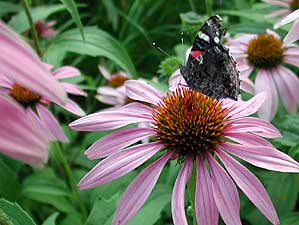|
Photos
More from MPR
Your Voice
|
Prairie gardening in the city
July 27, 2004
 |
| Carolyn Carr's urban prairie is a haven for birds, bees, butterflies and other wildlife. (MPR Photo/Kate Smith) |
Minneapolis, Minn. — There's a new kind of gardener -- people who love the look of the tall, somewhat scraggly plants that once made up the tall grass prairies of the upper midwest. Carolyn Carr is one of these gardeners. For her, the beauty of a garden shows not only in its blossoms, but in its sustainability and the wildlife it attracts.
That's what Carr has carved out in her south Minneapolis yard. Her front yard garden is small patch of prairie. There are pink and grey-headed coneflowers, bright purple liatris, and deep pink monarda.
"Our yard is alive, it's moving, it's doing interesting things. The kids on the block like to hang out there. Our neighbors say, 'We really like to be in your yard, because we see interesting things'. It creates a different aesthetic that a lot of people enjoy," Carr said.
 | |||
Carr's love of prairie plants is spreading across her neighborhood. A conservation biologist, Carr lives in the Longfellow neighborhood of south Minneapolis. She's been active with her neighborhood association's efforts to preserve native plant life in the area.
But Carr didn't want to stop at just her yard. She founded a program, in its second year, that encourages other homeowners to plant native grasses and flowers in their landscape. The native plant grant program is coordinated by the Longfellow Community Council with money from the Mississippi Watershed Management Organization.
Carr says there are several advantages to landscaping with native plants. The perennials come back year after year, so they reduce the amount of mowing a homeowner does, cutting down on pollution. The plants soak up run-off, so less storm water runs into the nearby Mississippi River. And Carr says a native landscape is more dynamic than the typical lawn. It provides a home for butterflies, bees, birds and other wildlife.
The trend toward landscaping with native plants is taking off in Carr's neighborhood. She's seen neighbors casually embrace the move, or go all out.
"Some people are adding just a few native plants here and there. And other people are actually taking replacing large parts of their yards with native trees and shrubs, prairie wildflowers and woodland plants," Carr said.
 | |||
There are two ways to landscape with native plants according to Carr. The first is to rip up your lawn, and plant it with native flower and grass seed. That's the cheapest option. But Carr says it leads to a lot of work for homeowners who end up weeding their backyard prairie until it's established.
The other option involves using established native plants. That can cost more, but Carr says it has faster results.
"One option lots of people use is to smother their turf with a thick layer of newsprint covered by a layer of wood chip mulch that is three to five inches thick. Then they plant prairie seedlings into that mulch. The advantage is the plants already have big roots and they're ready grow quickly. In the first season you can have flowers blooming and grasses forming seed heads," Carr said.
The Longfellow Neighborhood Association offered 100 homeowners matching grants in the latest effort to bring back native plants to the neighborhood. Carr and other volunteers also present workshops, so homeowners new to native gardening can get tips on how to grow a garden full of native plants.
|
News Headlines
|
Related Subjects
|
